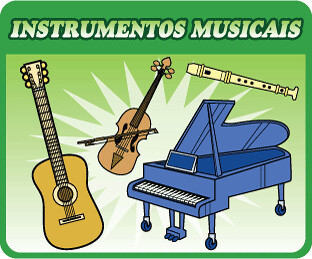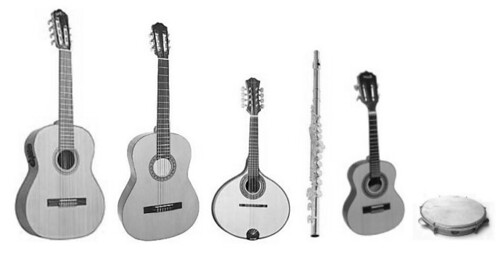Bom dia! I was preparing a post about chorinho and thought that it would be a good idea to introduce you to the vocabulary of musical instruments in Portuguese first. I also have a couple of very nice students who are musicians who may find this useful.
If you are a beginner, don't worry too much if you don't understand a lot of the words in the readings and video, just get as much as you can. If you are an intermediate student, this may be perfect for you. If you are an advanced speaker of Portuguese, you may still learn a new word or two... and I follow the links to some readings that are more advanced.
Parte I: Os Instrumentos Musicais
Aqui estão alguns instrumentos músicais:
Esses intrumentos são parecidos (similares), mas são diferentes:
Note que a guitarra é elétrica e o violão geralmente é acústico. O cavaquinho é bem pequenininho.
Aqui estão outros instrumentos:

 gaita
gaitabateria

 pandeiro sanfona
pandeiro sanfonaO pandeiro é muito importante no samba e a sanfona é muito importante no forró.
O Slash (dos Guns and Roses) toca guitarra e o João Gilberto toca violão.
Você sabia que o Woody Allen toca clarineta?
Atividades:
Responda as perguntas (answer whichever ones you can):
a. Você toca algum instrumento musical?
b. Você tem algum instrumento musical?
c. Qual é o seu instrumento favorito?
d. Qual dos instrumentos acima é maior (mais pesado)?
e. Qual dos instrumentos acima é menor (mais leve)?
f. Qual instrumento o Kenny G. toca?
g. Dê o nome de um instrumento que é importante no samba.
h. Dê o nome de um instrumento que é importante no jazz.
i. Dê o nome de um instrumento que é importante no rock.
j. Dê o nome de um instrumento que é importante na bossa nova.
Jogue esse jogo sobre instrumentos. Fale o nome dos instrumentos em voz alta.
Opcional: leia esse artigo sobre instrumentos importantes na música brasileira (if you can, don't worry if don't understand everything. Beginners may just read the name of the instruments matched with the drawings) .
Desafio (challenge): play a game of forca (hangman), where all words are instrumentos músicais. (Don't worry if you don't know all of the words in the game: I and a lot of Brazilians wouldn't know all those words ourselves!)
PARTE II: Os instrumentos do Choro
Essa parte é sobre os instrumentos importantes no choro. Para saber um pouco sobre o choro, veja as links no meu artigo sobre o choro.
Atividades:
Leia o artigo Os instrumentos do choro (if you can, don't worry if don't understand everything. Beginners may just read the name of the instruments matched with the drawings).
Advanced students: leia este artigo.
Conecte o nome do instrument com a foto:
Exemplo:
Violão de seis cordas: _1__
cavaquinho: ___
bandolim:___
violão:___
flauta: ___
pandeiro ___
O seguinte vídeo sobre um instrumento importante no choro, no samba e no pagode. Adivinha qual é o instrumento!
Aqui está o vídeo, com perguntas para responder (the host of the quiz doesn't support Portuguese characters, so there are no acentos in the quiz :-( ). Click here to see the complete test.
(If you are a my student in a class or private lessons, ask me for a code to share your results or grab it from our private wiki).
Gente! O Eduardo Sant'Anna não é incrível?
Opcional: leia as partes do violão e escute o vídeo de novo. Você consegue reconhecer alguma parte?
Now that you know the names of the instruments used in chorinho, enjoy some of the music!













